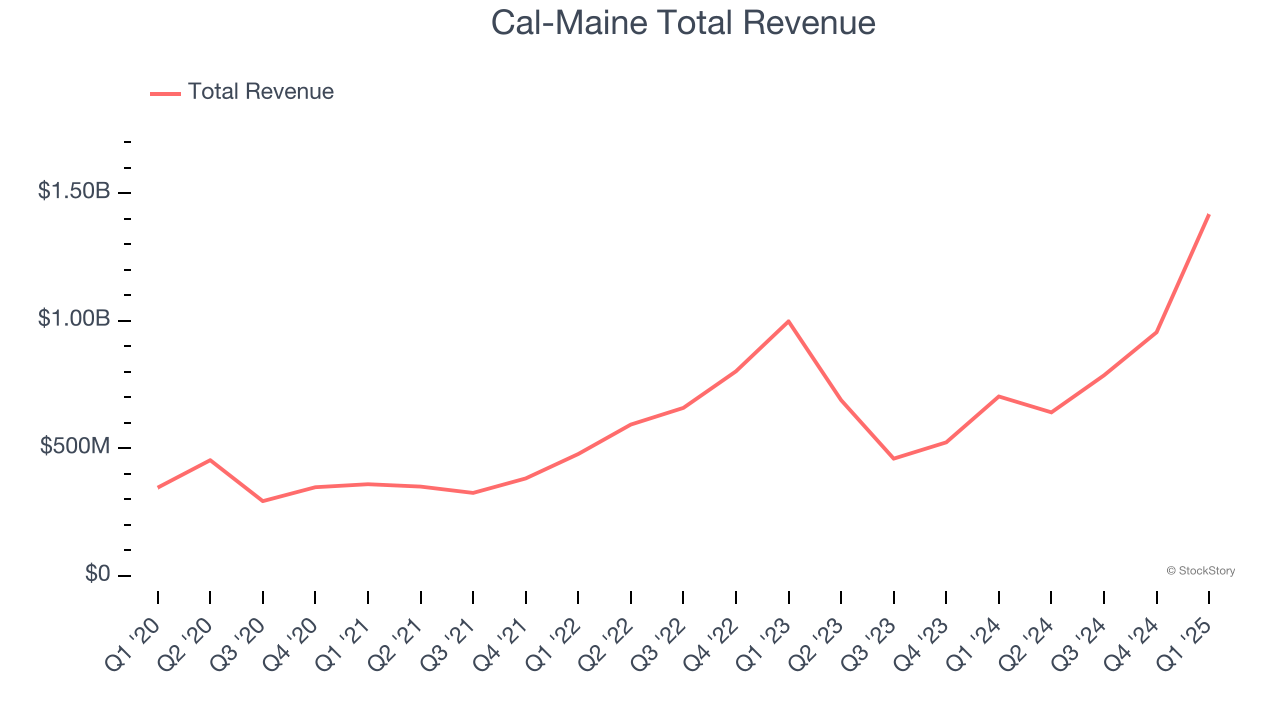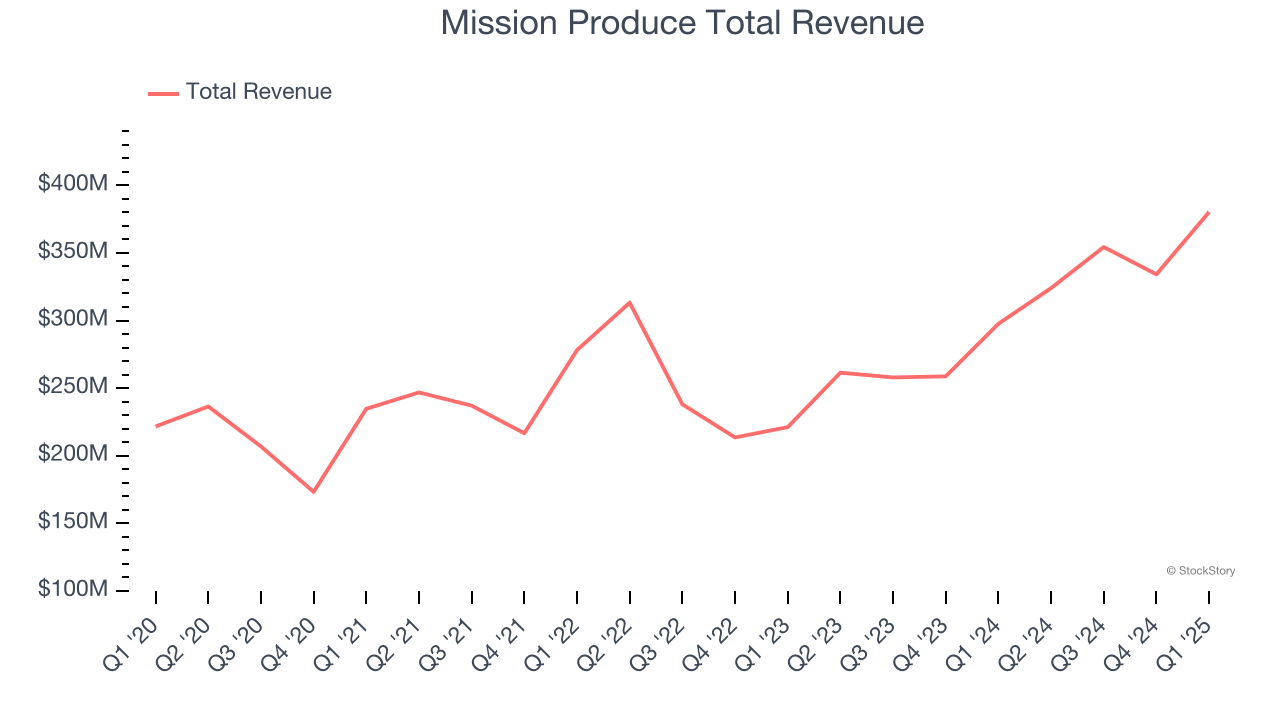
As the Q1 earnings season comes to a close, it’s time to take stock of this quarter’s best and worst performers in the perishable food industry, including Cal-Maine (NASDAQ:CALM) and its peers.
The perishable food industry is diverse, encompassing large-scale producers and distributors to specialty and artisanal brands. These companies sell produce, dairy products, meats, and baked goods and have become integral to serving modern American consumers who prioritize freshness, quality, and nutritional value. Investing in perishable food stocks presents both opportunities and challenges. While the perishable nature of products can introduce risks related to supply chain management and shelf life, it also creates a constant demand driven by the necessity for fresh food. Companies that can efficiently manage inventory, distribution, and quality control are well-positioned to thrive in this competitive market. Navigating the perishable food industry requires adherence to strict food safety standards, regulations, and labeling requirements.
The 11 perishable food stocks we track reported a slower Q1. As a group, revenues beat analysts’ consensus estimates by 1.4%.
In light of this news, share prices of the companies have held steady as they are up 2.8% on average since the latest earnings results.
Cal-Maine (NASDAQ:CALM)
Known for brands such as Egg-Land’s Best and Land O’ Lakes, Cal-Maine (NASDAQ:CALM) produces, packages, and distributes eggs.
Cal-Maine reported revenues of $1.42 billion, up 102% year on year. This print fell short of analysts’ expectations by 0.8%. Overall, it was a softer quarter for the company with a significant miss of analysts’ EBITDA estimates and a miss of analysts’ gross margin estimates.

Cal-Maine pulled off the fastest revenue growth of the whole group. Unsurprisingly, the stock is up 13.8% since reporting and currently trades at $103.
Is now the time to buy Cal-Maine? Access our full analysis of the earnings results here, it’s free.
Best Q1: Mission Produce (NASDAQ:AVO)
Founded in 1983 in California, Mission Produce (NASDAQ:AVO) grows, packages, and distributes avocados.
Mission Produce reported revenues of $380.3 million, up 27.8% year on year, outperforming analysts’ expectations by 28.4%. The business had a stunning quarter with a solid beat of analysts’ EPS estimates and an impressive beat of analysts’ EBITDA estimates.

Mission Produce delivered the biggest analyst estimates beat among its peers. The market seems happy with the results as the stock is up 14.8% since reporting. It currently trades at $12.10.
Is now the time to buy Mission Produce? Access our full analysis of the earnings results here, it’s free.
Weakest Q1: Beyond Meat (NASDAQ:BYND)
A pioneer at the forefront of the plant-based protein revolution, Beyond Meat (NASDAQ:BYND) is a food company specializing in alternatives to traditional meat products.
Beyond Meat reported revenues of $68.73 million, down 9.1% year on year, falling short of analysts’ expectations by 8.3%. It was a disappointing quarter as it posted a significant miss of analysts’ adjusted operating income estimates.
Beyond Meat delivered the weakest performance against analyst estimates and slowest revenue growth in the group. Interestingly, the stock is up 36.8% since the results and currently trades at $3.49.
Read our full analysis of Beyond Meat’s results here.
Vital Farms (NASDAQ:VITL)
With an emphasis on ethically produced products, Vital Farms (NASDAQ:VITL) specializes in pasture-raised eggs and butter.
Vital Farms reported revenues of $162.2 million, up 9.6% year on year. This number was in line with analysts’ expectations. Overall, it was a very strong quarter as it also logged a solid beat of analysts’ EPS estimates and an impressive beat of analysts’ EBITDA estimates.
Vital Farms achieved the highest full-year guidance raise among its peers. The stock is up 6.9% since reporting and currently trades at $38.50.
Read our full, actionable report on Vital Farms here, it’s free.
Tyson Foods (NYSE:TSN)
Started as a simple trucking business, Tyson Foods (NYSE:TSN) is one of the world’s largest producers of chicken, beef, and pork.
Tyson Foods reported revenues of $13.07 billion, flat year on year. This result came in 0.7% below analysts' expectations. In spite of that, it was a strong quarter as it produced a solid beat of analysts’ EBITDA estimates and a decent beat of analysts’ EPS estimates.
The stock is down 6.1% since reporting and currently trades at $57.10.
Read our full, actionable report on Tyson Foods here, it’s free.
Market Update
Thanks to the Fed’s rate hikes in 2022 and 2023, inflation has been on a steady path downward, easing back toward that 2% sweet spot. Fortunately (miraculously to some), all this tightening didn’t send the economy tumbling into a recession, so here we are, cautiously celebrating a soft landing. The cherry on top? Recent rate cuts (half a point in September 2024, a quarter in November) have propped up markets, especially after Trump’s November win lit a fire under major indices and sent them to all-time highs. However, there’s still plenty to ponder — tariffs, corporate tax cuts, and what 2025 might hold for the economy.
Want to invest in winners with rock-solid fundamentals? Check out our 9 Best Market-Beating Stocks and add them to your watchlist. These companies are poised for growth regardless of the political or macroeconomic climate.
